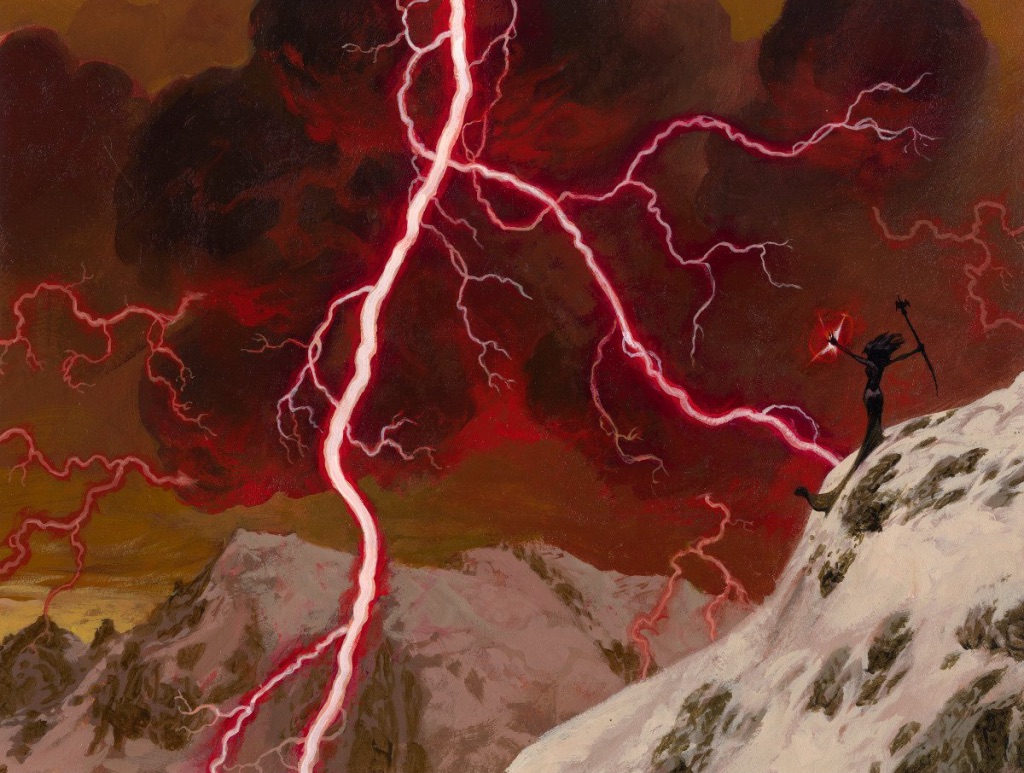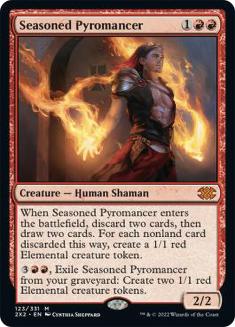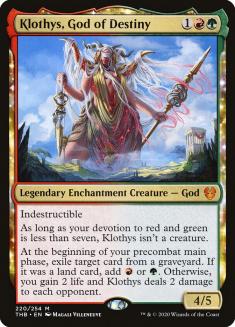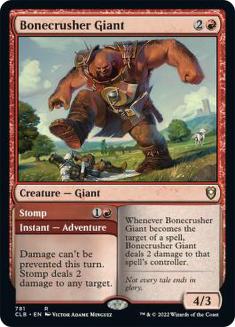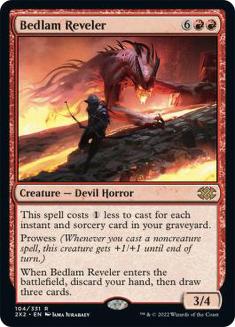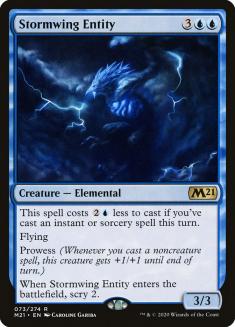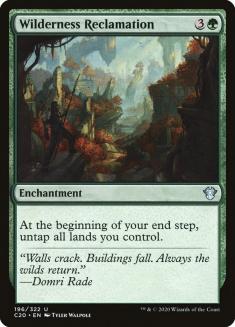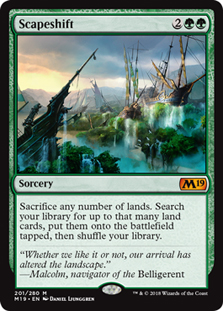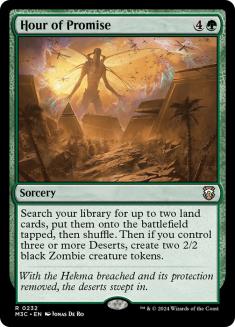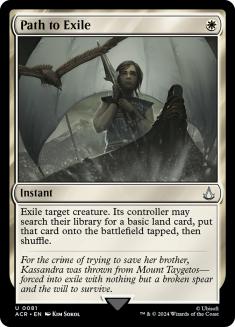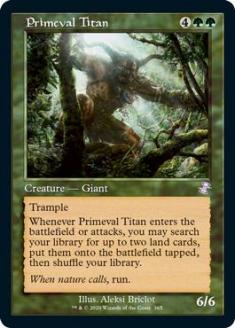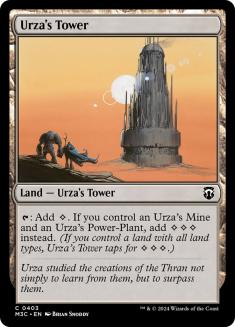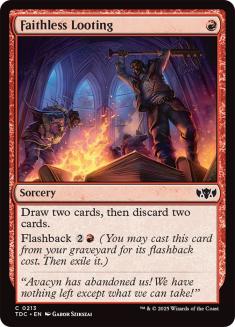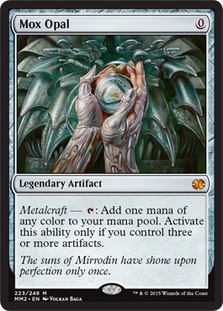Modern is moving again and it’s left me behind. Last year, the format felt so familiar — the toughest decision was which colour to splash in your Amulet Titan sideboard this week or whether you wanted Surgical Extraction or Gut Shot to help trigger Arclight Phoenix. Every popular deck from that era that wasn’t wiped out altogether or cut down to size by bans has struggled to survive the changes unleashed by every set since War of the Spark. It’s refreshing that the top tier looks completely different but also intimidating for anyone returning to the format after a long break or looking to get an edge for an upcoming event.
One staple of current Modern is a sign of just how much things have changed:
Creatures (27)
- 4 Magus of the Moon
- 4 Bloodbraid Elf
- 4 Arbor Elf
- 2 Scavenging Ooze
- 4 Seasoned Pyromancer
- 3 Bonecrusher Giant
- 3 Klothys, God of Destiny
- 3 Elder Gargaroth
Planeswalkers (2)
Lands (20)
Spells (11)
Sideboard

Gruul Midrange was once an object of ridicule. Its card quality was pathetic for most formats (let alone Modern!) and even the decks it hoped to prey on with Blood Moon and a barrage of land destruction spells still boasted a fine matchup against it. Losing to Gruul Midrange was the kind of nonsensical blindside that’s part of the price of admission for Modern.
Now, losing to Gruul Midrange is par for the course. While other recent printings spawned entirely new decks built and named for them – Urza, Lord High Artificer and Hogaak, Arisen Necropolis come to mind – Gruul Midrange benefits from upgrading its overall card quality. Seasoned Pyromancer is a threat that resists removal, cashes in conditional cards like Blood Moon or Lightning Bolt as required, and gives you something useful to do at every stage of the game. Klothys, God of Destiny does a little bit of everything. It ramps you towards your choice of curve-topping threat in Glorybringer or Elder Gargaroth (another new and welcome addition); keeps graveyards in check against Uro, Titan of Nature’s Wrath and Mystic Sanctuary; and pads your life total while whittling down the opponent’s from a safe distance.
Gruul Midrange aims to use Arbor Elf and Utopia Sprawl to bypass two-drops and jump up the curve but this doesn’t always work. Bonecrusher Giant offers a two-drop and three-drop in one while Wrenn and Six is the ideal threat against control decks, ensures you always hit your land drops and have fuel for Seasoned Pyromancer, and helps Lava Dart make the format even more hostile for one-toughness creature.
If the old Gruul Midrange decks were gimmicks hoping to punish poor manabases, this new edition is a solid deck that excels at playing ‘fair’ Magic while still getting free wins from Blood Moon effects. Modern’s best running joke is finally having the last laugh.
Monastery Swiftspear is still a pillar of Modern in various forms:
Creatures (12)
Lands (18)
Spells (30)
- 4 Lightning Bolt
- 4 Lava Dart
- 4 Mishra's Bauble
- 4 Manamorphose
- 4 Mutagenic Growth
- 2 Boros Charm
- 4 Crash Through
- 4 Light Up the Stage
Sideboard

Creatures (17)
Lands (18)
Spells (25)
Sideboard

Creatures (15)
Lands (19)
Spells (26)

Creatures (14)
Lands (18)
Spells (28)
- 4 Lightning Bolt
- 4 Lava Spike
- 4 Lava Dart
- 4 Mishra's Bauble
- 4 Manamorphose
- 4 Crash Through
- 4 Light Up the Stage
Sideboard

Every Prowess deck has the same elevator pitch — play Prowess threats and a flurry of cheap spells to threaten fast kills with ways to reload or overpower the opponent in the mid-game:
This is more than a choice of skins: there are meaningful differences between Mono-Red, Izzet, and Rakdos Prowess and ignoring these throws away equity against an archetype you will have to beat to win a Modern tournament. Many players learned this lesson the hard way when the original Mono-Red Prowess decks emerged, treating the matchup the same as Boros Burn and wondering why they kept losing; while Burn tries to count to twenty in predictable increments, making pure lifegain effective as long as you can handle their creatures, Prowess can play a longer game by assembling a bigger battlefield so that every spell translates to more damage. Timely Reinforcements or Weather the Storm are often game-ending against Burn and just a delaying tactic against Prowess.
Similarly, cards and tactics that are useful against one Prowess variant can be much worse against another. Understanding the strengths and weaknesses of each is essential for adapting properly (or for choosing one as your weapon).
Mono-Red Prowess
- Typically deals more direct damage than other Prowess variants between some mix of Lava Spike, Bonecrusher Giant, Firebolt, and Burst Lightning; a single-digit life total is in serious danger and you can’t expect a fragile creature to survive as often.
- Crash Through makes it much harder to contain ground attackers, notably Kiln Fiend in some lists.
- Bedlam Reveler provides the strongest and ‘cheapest’ (at a certain point) single-card end-game across all Prowess decks.
- The cleanest manabase — no unfortunate mid-game Blackcleave Cliffs or Spirebluff Canal, never lacking Mountains for Lava Dart — and also the least painful, crucial when the pseudo-mirror is a popular and important matchup.
Izzet Prowess
- Prowess creatures are much scarier with flying; the combination of burn and tools like Crash Through make it tough for ‘creature decks’ to profitably block against any Prowess deck but single cards like Uro, Tarmogoyf, Death’s Shadow, and Field of the Dead are much easier to fight through with Sprite Dragon and Stormwing Entity.
- There’s a reason Sprite Dragon succeeded where Stormchaser Mage failed; the permanent damage boost from every spell makes Sprite Dragon the best of all the ‘cheap’ Prowess threats when you have few resources to work with or need to set up attacks over several turns.
- Stormwing Entity dodges a large swathe of Modern’s premium removal: Fatal Push can’t touch it and removal that deals damage is nullified by an instant (even Dismember can’t take down an Entity through Mutagenic Growth, increasingly common because of its power in mirrors). Path to Exile gives Izzet Prowess another resource back but it can’t use this as effectively as its cousins with Bedlam Reveler or Lurrus of the Dream-Den. More narrow removal like Chandra’s Defeat, Celestial Purge, or Aether Gust targeted at Prowess as a whole has a glaring weakness to Stormwing Entity.
- Stormwing Entity encourages the use of free spells that can help deploy it on Turn 2. Mutagenic Growth is notably awkward here as it often lacks a valid target. This adds to the variance that all Prowess decks tend to suffer from; it’s somewhat easy to strand a Stormwing Entity for enough time that it won’t do anything useful.
Rakdos Prowess (Lurrus)
- The most flexible and multi-dimensional Prowess variant: Thoughtseize and Cling to Dust allow Rakdos Prowess to interact on unique axes while Lurrus is an on-demand way to press your advantage or recover in the mid-game.
- This comes at the cost of the sheer speed that defines other Prowess variants; these black spells demand more careful timing than red cards that can be fired off at will for Prowess triggers. Thoughtseize looks lost in a strategy that wants to render the opponent’s resources irrelevant rather than trading them away (the ‘burn spells plus Thoughtseize’ deck is a classic trap for newer players). However, Thoughtseize is the single best card against some of the linear decks people may pick up to race Prowess; when Rakdos Prowess was king under the old companion rules, Thoughtseize was what kept matchups like Ad Nauseam tenable.
- These competing incentives are seen in the creature selection too. Abbot of Keral Keep is slow but resilient, pairing well with the Unearth + Kolaghan’s Command + Lurrus recursion engine, while Kiln Fiend makes a tantalizing offer of easy Turn 3 kills. Rakdos Prowess can clear the way for Kiln Fiend with Thoughtseize but can’t convert that to an immediate win as easily.
Boros Prowess (Lurrus):
- The least popular variant in recent weeks but still bears the endorsement of accomplished red mages. Boros Prowess gets to freeroll Lurrus as a companion with an on-colour Horizon land in Sunbaked Canyon, avoiding some of the mana issues of Rakdos Prowess. Seeker of the Way is the perfect Prowess threat for winning races, which looks appealing again in a hall of mirrors.
- The main draw to white is Burrenton Forge-Tender and/or Kor Firewalker but these are less reliable against Sprite Dragon or Stormwing Entity in Izzet Prowess or Bonecrusher Giant anywhere. Chained to the Rocks is the rare removal spell that actually does line up well against Entity.
Awareness of these distinctions should inform your deckbuilding and in-game choices. For example, if you are tweaking your Jund deck with Prowess in mind, your first instinct may be to stock up on cheap removal and expect to win if you can clear the battlefield without taking much damage. This plan is likely to work against Mono-Red Prowess but not Rakdos Prowess, which can beat Jund at its own grindy game.
There, your life total is under less pressure early and you’d rather use your removal to back up large threats like Tarmogoyf or Scavenging Ooze. Cards like Kolaghan’s Command or Bloodbraid Elf that rot in your hand against faster lists have more room to shine here. Flexible graveyard hate like Nihil Spellbomb does nothing against Izzet, is marginally effective against Mono-Red in longer games against Bedlam Reveler, and is actively strong against Rakdos Prowess as it cuts off their recursion.
You know you want more removal, but what does that mean? One-mana interaction is important to have enough early plays or threaten double-spell turns but the typical Jund list runs enough that you may prefer to make up these numbers with more expensive removal that always hits the edge cases like Bedlam Reveler or Stormwing Entity: less Flame Slash, more Go for the Throat.
Another pillar of Modern is a green giant that isn’t leaving anyone jolly:
Creatures (5)
Planeswalkers (4)
Lands (29)
- 2 Island
- 1 Polluted Delta
- 4 Flooded Strand
- 1 Snow-Covered Plains
- 2 Snow-Covered Island
- 1 Snow-Covered Forest
- 1 Oboro, Palace in the Clouds
- 1 Temple Garden
- 2 Breeding Pool
- 1 Hallowed Fountain
- 4 Misty Rainforest
- 1 Scalding Tarn
- 1 Irrigated Farmland
- 2 Field of Ruin
- 2 Field of the Dead
- 2 Mystic Sanctuary
- 1 Ketria Triome
Spells (22)

Creatures (4)
Planeswalkers (2)
Lands (27)
Spells (27)

Creatures (3)
Lands (28)
- 1 Forest
- 1 Island
- 4 Polluted Delta
- 2 Snow-Covered Island
- 1 Snow-Covered Forest
- 1 Snow-Covered Swamp
- 1 Oboro, Palace in the Clouds
- 1 Watery Grave
- 1 Breeding Pool
- 1 Sunken Ruins
- 1 Flooded Grove
- 4 Misty Rainforest
- 1 Hinterland Harbor
- 2 Field of Ruin
- 2 Field of the Dead
- 1 Castle Vantress
- 2 Mystic Sanctuary
- 1 Zagoth Triome
Spells (29)

If you want to escape from Uro, your options are running out — Vintage if you’re a prince, Pauper if you’re not. If you just want to escape Uro, this is the format for you. Modern’s best Titan (typing that is painful) has revolutionized control decks and will be a fixture of the format until the hammer falls once more – if not on Uro, at least on Mystic Sanctuary.
It’s no surprise that these strategies have shifted to the combo-control model that made Temur Reclamation so scary in Standard, Historic, and now Pioneer. Growth Spiral allows each of these decks to build towards some payoff that cares about lands, going over the top of anything that opponent can do. Wilderness Reclamation with Nexus of Fate has gained traction in part because it does that better against other blue decks trying the same thing.
It’s striking how little these Modern Wilderness Reclamation decks rely on or use their namesake card, prompting the question of whether it’s Reclamation itself driving this success or the structural changes made to accommodate it. I suspect Fact or Fiction is the real innovation here and that these non-Reclamation blue decks should be looking to support it with better, less conditional cards that don’t also cost four mana.
Without Arcum’s Astrolabe to blur the colour pie in a way not seen since Cloudthresher, Cruel Ultimatum, and Wrath of God sat side-by-side in Standard, the choice of tertiary colour is more difficult.
This choice is first and foremost about removal, informed by the discussion above. Uro itself is an argument in favour of Path and Push but only a minor one; a bigger concern is creatures like Death’s Shadow and Tarmogoyf that are awfully hard to kill for a Temur deck leaning on Lightning Bolt.
Celestial Purge is a strong argument for white, as exiling threats matters against Rakdos Prowess and Purge has broad utility against Gruul Midrange, Jund, and Death’s Shadow as well as blue mirror-breakers in Wrenn and Six and Ashiok, Dream Render. I recommended Bant Ramp for this week’s What We’d Play because I think Teferi, Time Raveler and Dovin’s Veto put that fight in your favour again and Supreme Verdict is the best sweeper in the format (especially when Growth Spiral lets you cast it early enough for it to matter against Prowess).
With these as the established best decks, what’s the next step?
Creatures (13)
Lands (19)
Spells (28)

Creatures (15)
Lands (17)
Spells (28)

Modern players haven’t walked through the valley of the shadow of death or feared evil recently; it’s time for that to change. For a Gruul Midrange deck with land destruction, a deck designed to play on one land with a one-drop that embarrasses Elder Gargaroth is a nightmare. Death’s Shadow’s goal of downsizing the game by aggressively trading off resources is well-suited to fighting Prowess; when both players are low on cards, you’d rather have Death’s Shadow than Soul-Scar Mage.
Traditionally, this goal has been less effective against control decks even when their card quality was far lower and they were committed to closing the game with Celestial Colonnade. Grixis Death’s Shadow has gained nothing since then; the control decks have gained everything they ever wanted. Why would Death’s Shadow loom over Modern again?
The answer is that then, as now, the white removal was key. Path to Exile and Supreme Verdict alongside Snapcaster Mage and planeswalkers was too much for Grixis Death’s Shadow to fight through consistently; by contrast, Death’s Shadow decks of every stripe sliced through decks like Blue Moon and Izzet Through the Breach that couldn’t contain their threats.
The Temur Reclamation deck that Lavaridge is using to dominate Magic Online is much more in the second camp — the fundamentals of the matchup favour Death’s Shadow, and if Uro and Mystic Sanctuary threaten to swing it for Reclamation, Death’s Shadow’s one new tool in Cling to Dust can address that. The dominance of Wrenn and Six and Lava Dart has also forced Humans, Grixis Death’s Shadow’s former nemesis, out of the format along with other creature-heavy aggressive decks that could pose a problem (Rakdos Goblins, the talk of the town just a month ago, is conspicuous by its absence).
If the Prowess decks slow down to go over the top of each other, this creates a theoretical opening for big-mana strategies to remind Modern players to show some respect. That’s about the only hope this macro-archetype can cling to at the moment; the best aggressive deck in the format can race you, the control decks are effectively combo-control decks that can stop all but your best starts and quickly slam the door shut, and the default midrange deck maindecks a set of Blood Moon. It’s hard to remember that Amulet Titan was the consensus best deck, even forcing the ban of Once Upon a Time, in this calendar year. It’s been a long six months!
We can tease out a larger narrative about the role of linear decks in Modern and why their downfall has harmed the format’s diversity. When the format’s top decks have a large and stationary target, players know the rules of engagement — the wacky tribal deck I’m bringing to Friday Night Magic surely can’t compete with Affinity on the merits, but I could load up my sideboard with Stony Silence (or any of Karn, the Great Creator; Collector Ouphe; or Force of Vigor, whose appearance together within two months makes the Mox Opal ban even more quizzical) and bring a nuclear warhead to that knife fight.
“Should I run Rest in Peace or Damping Sphere this weekend?” is a fairly banal question and those cards rarely make games more interesting but these measures allow you to compete with decks that are otherwise out of your league. No equivalent cards exist for Modern’s current frontbench; the closest examples are Choke or Boil against Mystic Sanctuary decks or Chalice of the Void against Prowess (in the handful of decks that can support it, where it isn’t even good on the draw most of the time). Meanwhile, cards like Lava Dart and Force of Negation place severe constraints on the format (how bold do you have to be to show up with Noble Hierarch?!). The stereotype of Modern as an uninteractive shootout between linear decks has rarely been less true. At long last, the best deck runs Cryptic Command! Perhaps we should be careful what we wish for…
Ultimately, any attempt to understand Modern can only go so far — 80-card Kiki-Chord won the Modern Challenge on Magic Online this weekend! — but this should give you a rough idea of its contours. It’s harder than ever to beat them; consider joining them until the format shifts beyond recognition once more.

